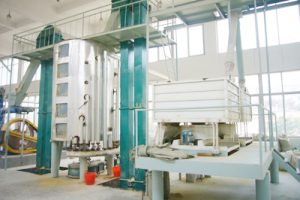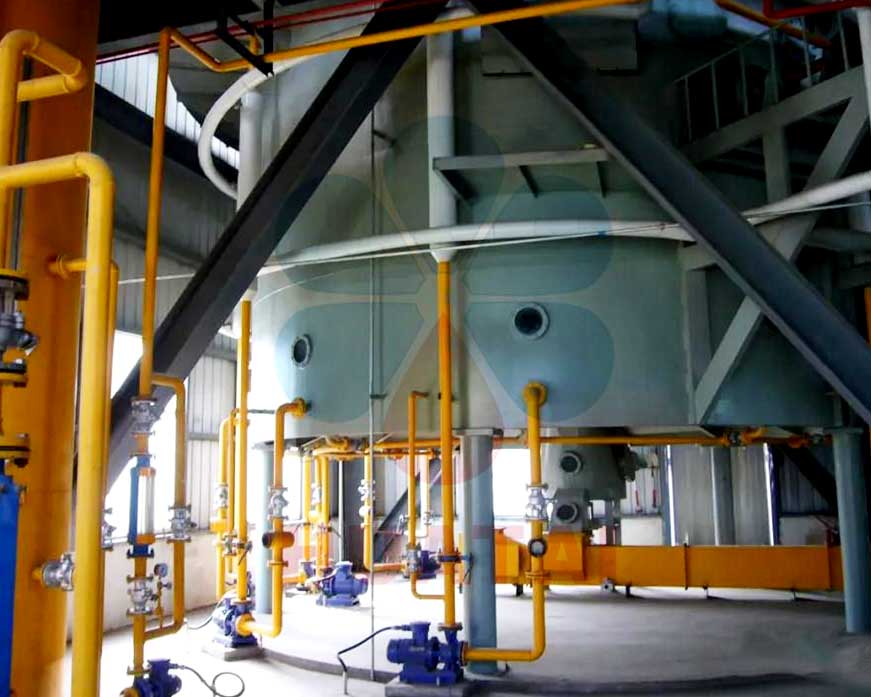Rice bran oil can be produced by oil pressing or oil solvent extraction. The crude oil contains various active enzymes and impurities, which will cause the rice bran raw materials and extracted crude oil to acidify quickly. Therefore, the raw materials and crude oil need to be processed in time to ensure its quality.

The oil content of rice bran is low, and the extraction efficiency of rice bran oil pressing process is low and the output is small. However, the rice bran oil solvent extraction process in rice bran oil solvent extraction plant can well extract the oil in the rice bran and control the amount of residual oil in the extracted cake to a low proportion. The production efficiency is high and the oil yield is high, so rice bran oil plants with larger output usually choose the rice bran oil solvent extraction process to produce rice bran oil.
The 150TPD rice bran oil production line can be divided into three parts: rice bran pretreatment section, rice bran oil solvent extraction section, and crude rice bran oil refining section.
Rice Bran Oil Pretreatment Process:
1. Rice bran and tips separation section: Rice bran first needs to pass through bran separation screen to remove impurities such as broken rice and coarse bran husks.
2. Rice bran softening and condition section: The cleaned rice bran will be sent to the conditioning pot, where its temperature and moisture will be adjusted to a state suitable for expansion.
3. Rice bran expansion section: The purpose of expansion is to destroy the cell tissue of rice bran, change its internal porosity, and increase the permeability inside the rice bran, thereby improving the efficiency of rice bran extraction.
4. Drying: Before solvent extraction, rice bran needs to be dried, which is more conducive to its storage. At the same time, the moisture and temperature of the dried rice bran are also more conducive to the oil extraction.

Rice Bran Oil Solvent Extraction Machine:
The pretreated rice bran will enter the rice bran oil solvent extraction plant. Here, the rice bran will react with organic solvents and fully contact the rice bran cake through spraying, soaking, etc., thereby extract out the oil in the rice bran to obtain miscella. The miscella will go through evaporation, stripping and other steps to vaporize the solvent and separate it from the oil, thereby obtaining crude rice bran oil.
Rice Bran Oil Refining Machine:
The process flow of rice bran oil refining plant to oil mainly includes the following steps:
1. Crude oil filtration: Crude rice bran oil contains impurities such as cake residue, oil feet, soap stock, meal powder, etc. These impurities will affect subsequent rice bran oil refining process and increase oil loss. Filtration can use physical methods such as sedimentation, filtration, and centrifugation to remove insoluble impurities in crude rice bran oil.
2. Refining and degumming: Commonly used methods for degumming include hydration, acid refining and enzymatic degumming. Degumming can remove phospholipids, mucilage, resins, proteins, sugars, trace metals, etc. from crude oil to prepare for further refining.

3. Refining deacidification: Commonly used methods for deacidification include caustic soda or alkali neutralization method. The main purpose of refining and deacidification is to remove FFA (free fatty acids), acidic pigments, sulfides, oil-insoluble impurities and trace metals in oil to ensure the food safety of oil.
4. Refining and dewaxing: Dewaxing or degreasing mainly uses freezing, crystallization or winterization crystallization, and fractionation to remove wax fat or solid fat in oil. The wax content in rice bran oil is about 3% to 9%, which will increase the cloud point of the oil, reduce the transparency and digestion and absorption rate of the oil, and worsen the smell and palatability, thereby reducing the eating quality, nutritional value of rice bran oil and industrial use value, so they need to be removed.

150TPD Rice Bran Oil Production Line Solutions
Henan Huatai Cereals and Oils Machinery Co., Ltd. has been committed to the production and research and development of grain and oil machinery for 37+ years. It has mature production and manufacturing processes and skilled technical workers for edible oil processing machine, and is committed to providing customers with high-quality, cost-effective cooking oil equipment, mainly includes cooking oil press machine, edible oil extraction machine, vegetable oil refining equipment, complete edible oil production lines, etc. The equipment models are complete and the quality is good. Also, we provide customized services for edible oil mills to help clients solve different product needs. Our edible oil processing machine are sold to more than a dozen countries and are well received by domestic and foreign customers.
All in all, to consult and purchase rice bran oil processing machine, you can go to Huatai Oil Machinery. Please leave your inquiry information, such as: the type of your oil seed, machine capacity (TPD, how many tons to process per day), processing technology (Pressing, extraction, refining) or full set of production lines, etc. We will contact you ASAP and send you the complete features and specifications of the rice bran oil equipment. Welcome to visit our factory and for latest quotation.
Certifications:


